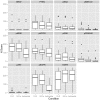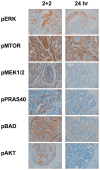Immunohistochemistry of colorectal cancer biomarker phosphorylation requires controlled tissue fixation
- PMID: 25409462
- PMCID: PMC4237459
- DOI: 10.1371/journal.pone.0113608
Immunohistochemistry of colorectal cancer biomarker phosphorylation requires controlled tissue fixation
Abstract
Phosphorylated signaling molecules are biomarkers of cancer pathophysiology and resistance to therapy, but because phosphoprotein analytes are often labile, poorly controlled clinical laboratory practices could prevent translation of research findings in this area from the bench to the bedside. We therefore compared multiple biomarker and phosphoprotein immunohistochemistry (IHC) results in 23 clinical colorectal carcinoma samples after either a novel, rapid tissue fixation protocol or a standard tissue fixation protocol employed by clinical laboratories, and we also investigated the effect of a defined post-operative "cold" ischemia period on these IHC results. We found that a one-hour cold ischemia interval, allowed by ASCO/CAP guidelines for certain cancer biomarker assays, is highly deleterious to certain phosphoprotein analytes, specifically the phosphorylated epidermal growth factor receptor (pEGFR), but shorter ischemic intervals (less than 17 minutes) facilitate preservation of phosphoproteins. Second, we found that a rapid 4-hour, two temperature, formalin fixation yielded superior staining in several cases with select markers (pEGFR, pBAD, pAKT) compared to a standard overnight room temperature fixation protocol, despite taking less time. These findings indicate that the future research and clinical utilities of phosphoprotein IHC for assessing colorectal carcinoma pathophysiology absolutely depend upon attention to preanalytical factors and rigorously controlled tissue fixation protocols.
Conflict of interest statement
Figures




Similar articles
-
Effect of immediate cold formalin fixation on phosphoprotein IHC tumor biomarker signal in liver tumors using a cold transport device.Sci Rep. 2020 Feb 7;10(1):2147. doi: 10.1038/s41598-020-58257-3. Sci Rep. 2020. PMID: 32034185 Free PMC article.
-
Determination of phosphorylated proteins in tissue specimens requires high-quality samples collected under stringent conditions.Histopathology. 2014 Feb;64(3):431-44. doi: 10.1111/his.12268. Epub 2013 Nov 23. Histopathology. 2014. PMID: 24266863
-
Rapid two-temperature formalin fixation.PLoS One. 2013;8(1):e54138. doi: 10.1371/journal.pone.0054138. Epub 2013 Jan 18. PLoS One. 2013. PMID: 23349806 Free PMC article.
-
Lymph node harvest in colorectal adenocarcinoma specimens: the impact of improved fixation and examination procedures.APMIS. 2011 Jun;119(6):347-55. doi: 10.1111/j.1600-0463.2011.02748.x. Epub 2011 Apr 12. APMIS. 2011. PMID: 21569092 Review.
-
Delay to Formalin Fixation (Cold Ischemia Time) Effect on Breast Cancer Molecules.Am J Clin Pathol. 2018 Mar 7;149(4):275-292. doi: 10.1093/ajcp/aqx164. Am J Clin Pathol. 2018. PMID: 29471352 Review.
Cited by
-
Rapid tissue processing using a temperature-controlled collection device to preserve tumor biomarkers.Cell Tissue Bank. 2020 Mar;21(1):89-97. doi: 10.1007/s10561-019-09800-8. Epub 2019 Dec 14. Cell Tissue Bank. 2020. PMID: 31838727 Free PMC article.
-
Impact of Preanalytical Factors on the Measurement of Tumor Tissue Biomarkers Using Immunohistochemistry.J Histochem Cytochem. 2021 May;69(5):297-320. doi: 10.1369/0022155421995600. Epub 2021 Mar 1. J Histochem Cytochem. 2021. PMID: 33641490 Free PMC article.
-
Colorectal carcinoma tumour budding and podia formation in the xenograft microenvironment.PLoS One. 2017 Oct 17;12(10):e0186271. doi: 10.1371/journal.pone.0186271. eCollection 2017. PLoS One. 2017. PMID: 29040282 Free PMC article.
-
Significance of E-cadherin and Vimentin as epithelial-mesenchymal transition markers in colorectal carcinoma prognosis.EXCLI J. 2020 Jun 26;19:917-926. doi: 10.17179/excli2020-1946. eCollection 2020. EXCLI J. 2020. PMID: 32665775 Free PMC article.
-
Real-life data from standardized preanalytical coding (SPREC) in tissue biobanking and its dual use for sample characterization and process optimization.J Pathol Clin Res. 2023 Mar;9(2):137-148. doi: 10.1002/cjp2.305. Epub 2022 Dec 8. J Pathol Clin Res. 2023. PMID: 36484086 Free PMC article.
References
-
- Wolff AC, Hammond ME, Schwartz JN, Hagerty KL, Allred DC, et al. (2007) American Society of Clinical Oncology/College of American Pathologists guideline recommendations for human epidermal growth factor receptor 2 testing in breast cancer. Arch Pathol Lab Med 131: 18–43. - PubMed
-
- Hammond ME, Hayes DF, Dowsett M, Allred DC, Hagerty KL, et al. (2010) American Society of Clinical Oncology/College of American Pathologists guideline recommendations for immunohistochemical testing of estrogen and progesterone receptors in breast cancer (unabridged version). Arch Pathol Lab Med 134: e48–72. - PubMed
-
- Hewitt S, Robinowitz M, Bogen S, Gown A, Kalra K, et al.. (2011) Quality Assurance for Design Control and Implementation of Immunohistochemistry Assays; Approved Guideline – Second Edition, CLSI Document I/LA28-A2. Wayne, Pennsylvania: Clinical and Laboratory Standards Institute.
-
- Yildiz-Aktas IZ, Dabbs DJ, Bhargava R (2012) The effect of cold ischemic time on the immunohistochemical evaluation of estrogen receptor, progesterone receptor, and HER2 expression in invasive breast carcinoma. Mod Pathol 25: 1098–1105. - PubMed
Publication types
MeSH terms
Substances
LinkOut - more resources
Full Text Sources
Other Literature Sources
Medical
Research Materials
Miscellaneous

